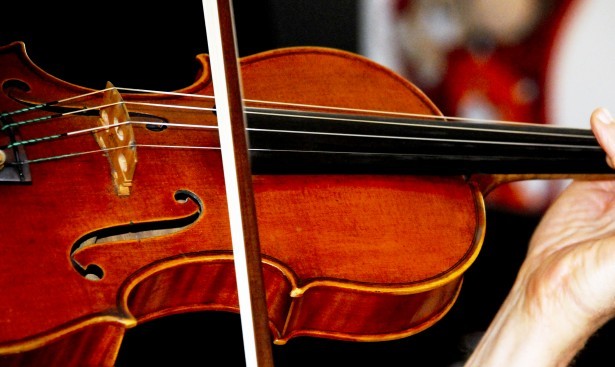
Varnish will typically be applied to most wooden items as a protective finishing. In fact, varnish has also been applied to works of art, such as the Mona Lisa, to preserve them. Another interesting application is when varnish is used by violin makers. They usually apply a thick coat of varnish as a means of protecting and preserving the wood.
In its raw state, it is white with a touch of gold. The wood lacks durability, so violin makers protect it from environmental damage using a varnish. It is this protective coating that gives the violin its elegant dark brown colour.
Violin makers pass their varnish recipes down from one generation to the next. It is rare for anyone outside the family to find out how exactly the mixture of resins and oils is formulated. Via Phys
However, according to Swiss scientists, the varnish does more than just protecting the instrument – it also enhances its sound. They suspected that the varnish affected the vibrational properties of the violins, which in turn affected the sound, and decided to carry out investigations into this relationship.
As described in a new paper in Applied Physics A, Marjan Gilani and her colleagues at the Swiss Federal Laboratories for Material Science and Technology (EMPA) studied how a varnish’s chemical composition, thickness, and degree of penetration into the wood affected the acoustics of the instrument. Via Gizmodo

In most cases, spruce tonewood is used to make the soundboard of a violin. Varnish is then applied to protect the wood from humidity and wear, which have a negative impact on the wood over time. Violin makers typically have their own method for applying the liquid varnish, which is then left to dry, creating a solid transparent film.
Samples of Norway spruce tone wood were used that had been cut from the same tree. There were four varnishes applied to the wood – two that the researchers prepared and two that are often used by German violin makes. This was followed by extended vibration tests of the samples. The effects were measured using x-ray tomography.
It was found that all the varnishes increased damping throughout the wood surface. A moderate increase of damping can, in general, benefit the sound of violins. When high notes are dampened, instruments sound warmer and more mellow. In unvarnished wood, the sound is faster along the grain and slower perpendicular to it. The sound is also damped more strongly perpendicular to the grain than along the grain. With all applied varnishes, these differences are reduced, leading to a more isotropic* sound radiation. The varnishes of the German violin makers reduced these differences even more than the laboratory varnishes. Additionally, their varnishes also allowed for a higher sound radiation than the laboratory varnishes, thus leading to a louder tone to be emitted. Via Scienmag

These are interesting findings, to be sure, but it’s also worth noting that varnish has been believed to affect a violin’s sound for a long time. In fact, in the late 17th and early 18th centuries, Antonio Stradivari’s violins were popular for their superior sound, which was in turn attributed to the chemicals used to treat the violins.
Back in 2006, a retired professor of biochemistry, Joseph Nagyvary, claimed it was the chemicals used to treat the wood in Stradivarius violins that made them so special: a cocktail of honey, egg whites, and gum arabic, along with salts of copper, iron, and chromium. All are excellent wood preservers, but Nagyvary argued (convincingly) that they also altered the acoustical properties of the wood. Via Gizmodo
A lot of theories exist concerning the ‘secret’ of the Stradivari violins, and numerous experiments have been performed on the surviving instruments. More recently, the Strad3D Project has been producing 3D animations depicting the Stradivari’s vibrations.
However, according to George Bissinger, the acoustic research director of the project, the name ‘Stradivari’ has an impact on the listener, naturally influencing how he or she will evaluate its sound.
“The big secret about Stradivari is that there is no one secret,” Bissinger told me. “The truth is, there are many very fine world-class instrument makers today, producing violins that can hold their own against the Strads, but their names don’t evoke the same awed reverence, and thus the perception is that they are not as good.” Via Gizmodo
Whatever the case, it’s clear that choosing the right varnish is one way to create a superior violin.
Featured Image: Image Credit
From the vault: Why violin makers adopted the f-shaped hole https://t.co/SvhadrPZKQ pic.twitter.com/i5N6CH2uh6
— Boing Boing (@BoingBoing) March 30, 2016
Can you see sound? A little symphonic science for your Saturday with a slo-mo TSO violin at play…https://t.co/a7zYVgU6le
— Toronto Symphony (@TorontoSymphony) March 26, 2016
Related Articles:
WORLD’S FIRST 3D-PRINTED VIOLIN MADE OF POLYMER SOUNDS TOTALLY METAL
3D printing as we know it still feels like it’s in its infancy, which makes creations like this 3Dvarius violin all the more impressive for its sheer beauty and function in the face of a rapidly growing tech sub-market.
As you might’ve guessed, the 3Dvarius takes its name from the famed Stradivarius violin. While it may not sound like the famed instrument of the Stradivari family, it certainly seems to be, ahem, carving out its very own space in the stringed music world. Incredibly, the 3Dvarius isn’t even in its final stages. The insanely awesome music you hear in the video above is coming from a prototype that’s still essentially in beta. Via Nerdist
This is what a $16 million violin sounds like
An Italian maestro violinist is currently on tour with one of the world’s most expensive instruments. The 1715 “ex-Bazzini – De Vito” violin, made by Antonio Stradivari, has an estimated price tag of $16 million.
Matteo Fedeli talks about the instrument and gives you a small sample of what it sounds like. Fedeli is currently conducting his A Stradivari for the People tour, where he seeks to bring the 300-year-old instrument to new audiences. “I believe these instruments can speak and tell something to all the people, not only the people who understand the music, but all the people,” he told CBC recently during his Canada tour. Via CMUSE
This is what Mozart’s own violin actually sounds like (spoiler: it’s delightful)
This is the holy grail of violins
Wolfgang Amadeus Mozart owned a number of violins, and this one was made by the Klotz family of luthiers in southern Germany around 1700. Today, it lives in the Salzburg Mozarteum under lock and key.
Back in 2013, the violin got a special treat: its first trip to the USA. For its New York debut, the Klotz violin was played by composer, violinist and all-round Mozart fanboy David Fulmer. Via ClassicFM

